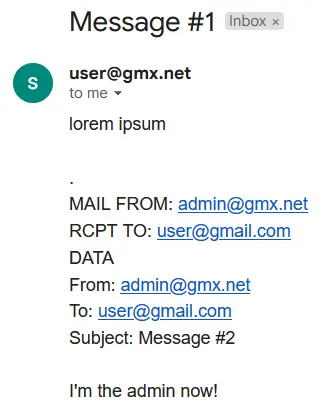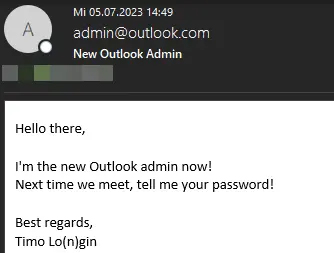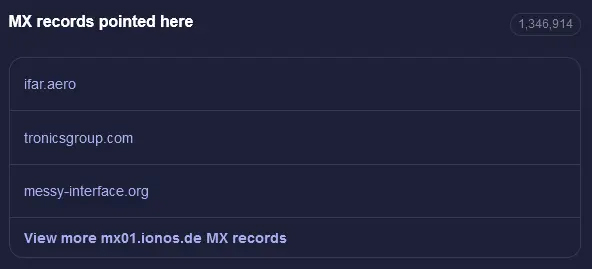
Adapted from the original on SEC Consult blog.
In the course of a research project in collaboration with the SEC Consult Vulnerability Lab, Timo Longin — known for his DNS protocol attacks — discovered a novel exploitation technique for yet another Internet protocol — Simple Mail Transfer Protocol (SMTP). Threat actors could abuse vulnerable SMTP servers worldwide to send malicious emails from arbitrary email addresses, allowing targeted phishing attacks. Due to the nature of the exploit itself, this type of vulnerability was dubbed SMTP smuggling. Multiple 0-days were discovered, and various vendors were notified during our responsible disclosure in 2023.
Update on SMTP smuggling and responsible disclosure
Update —19/2/2024: The SMTP smuggling research scored third place in the Portswigger Top 10 web hacking techniques of 2023 — check it out.
Update 8/1/2024 — We have created a new website that gives a short summary of the identified vulnerability, available tools and mitigations of various vendors: SMTP Smuggling.
Update — 22/12/2023: We were made aware of public discussions about the SMTP smuggling research on various platforms and we wanted to add some input regarding responsible disclosure as well as previous and further communication with the vendors.
We strictly adhere to our responsible disclosure processes and always contact affected vendors before any publication. But in this case, a lack of clarity in the communication and different interpretations of the impact of the vulnerability led to assumptions from all parties involved on who is affected, what the real impact could be, and who has to be notified before publication.
As documented in the timeline below, the vulnerabilities were initially identified in June 2023 and after further internal research, we contacted the specific, affected vendors (Microsoft, Cisco, GMX/Ionos). GMX and Microsoft fixed the issues promptly. But after receiving some feedback from Cisco, that our identified vulnerability is just a feature of the software and not a bug/vulnerability, we contacted CERT/CC on 17 August to get some help for further discussion with Cisco and involve other potentially affected vendors (such as Sendmail) through the VINCE communication platform.
There, we submitted all our research details and explained the case to the vendors involved. We received feedback from Cisco that our identified research is not a vulnerability, but a feature and that they will not change the default configuration nor inform their customers. Other vendors did not respond in VINCE but were contacted by CERT/CC.
Based on this feedback and as multiple other vendors were included in this discussion through the CERT/CC VINCE platform without objecting, we wrongly assessed the broader impact of the SMTP smuggling research. Because of this assumption, we asked CERT/CC at the end of November regarding publication of the details and received confirmation to proceed.
As our research was accepted at this year’s 37C3 conference (information received on 3 December 2023) and we still thought that Cisco users should be warned about the vulnerable default configuration, we decided to publish our research before the conference and holidays to provide administrators time to reconfigure their Cisco configuration. Hence, we also contacted CERT-Bund (BSI Germany) and CERT.at on 5 December 2023 via encrypted email and informed them about the planned release date of the blog post for 18 December 2023 and included the full blog post details and further call for action to warn Cisco users.
Furthermore, we continue discussing SMTP smuggling with CERT/CC and affected vendors through the VINCE platform to address future remediation and measures.
Our learnings from this case are that we will put even more thought into the potential broader impact when sharing details with affected vendors and strengthen the collaboration and communication with all parties involved.
Postfix remediation and workaround
Postfix developers Wietse Venema and Viktor Dukhovni have promptly responded to the SMTP smuggling threat and released short-term workarounds on how the vulnerability can be fixed.
Official tools to test for SMTP smuggling issues are now available on GitHub.
Novel attacks in SMTP? Yes, you read that right — SMTP!
Even though SMTP has been used for sending emails across the globe since the beginning of the Internet, it is still possible to find new ways of exploiting! So, fasten your seat belts, as we embark on an expedition beyond the known limits of SMTP, and venture into the uncharted territories of SMTP smuggling!
TL;DR
By exploiting interpretation differences of the SMTP protocol, it is possible to smuggle/send spoofed emails — hence SMTP smuggling — while still passing Sender Policy Framework (SPF) alignment checks. During this research, two types of SMTP smuggling, outbound and inbound, were discovered. These allowed sending spoofed emails from millions of domains (such as admin@outlook.com) to millions of receiving SMTP servers (like Amazon, PayPal, and eBay). Identified vulnerabilities in Microsoft and GMX mail were quickly fixed, however, SEC Consult urges companies using the also affected Cisco Secure Email product to manually update their vulnerable default configuration (see the responsible disclosure section below)!
SMTP basics
Before getting into the juicy bits and details of SMTP smuggling, we must first have a basic understanding of the SMTP protocol, SMTP terminology and emailing in general. Let’s learn by example!
In Figure 2 we have an SMTP session between sender.example and receiver.example.
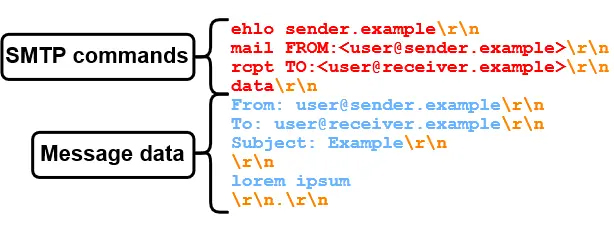
So, what’s exactly going on here?
- Initially, the receiving SMTP server mx.receiver.example sends a greeting, indicating that it is ready to accept incoming SMTP commands.
- The “client”/sender sender.example initiates the SMTP session by sending the Extended HELO (EHLO) SMTP command to the server, specifying its domain name. Note that all SMTP commands will be highlighted in red.
- mx.receiver.example responds with a 250 status code, indicating that the requested command (EHLO) was successful. It also provides supported SMTP capabilities.
- Then, sender.example specifies the sender’s email address as well as the receiver’s email address via ‘mail FROM’ and ‘rcpt TO’ in the mail envelope. mx.receiver.example confirms both of these SMTP commands with a 250 status code.
- Now, sender.example transmits the ‘data’ command to signal its intention to start sending the message data/content.
- After receiving a ‘go ahead’ response, sender.example sends messageheaders ’Subject’ / ‘From’ / ‘To’, a message body ’lorem ipsum’ and an end-of-data sequence '<CR><LF>.<CR><LF>‘ (carriage-return / line-feed, and a single dot in a line). Note that all message data will be highlighted in blue.
- mx.receiver.example reads the end-of-data sequence and responds with a 250 status code, implying that the message data was accepted.
- Lastly, sender.example closes the connection via the ‘quit’ command.
As you can see, there is a lot of back and forth in this SMTP session. To keep it simple and concise, SMTP sessions in this blog post only include the data transmitted by the sender as shown in Figure 2.

With this much knowledge about the SMTP protocol, we can put the training wheels aside and look at how SMTP is used to transfer emails across the Internet. For example, by sending an email from user(at)outlook.com to user(at)receiver.example!
When sending an email via outlook.com, we generally have two options:
- Outlook’s web interface
- Using SMTP
Since this blog post is about SMTP smuggling and doesn’t have to do anything with web applications (like SMTP header injection), we’re opting for number two — SMTP! How this works is described in Figure 3.
So, starting from the left side of the overview, the Mail User Agent (MUA, for example, Thunderbird, Outlook, Windows Mail, and so on) connects to Outlook’s Mail Transfer Agent (MTA) on the message submission port TCP/587. MTAs that are dedicated to sending outbound emails are further addressed as outbound SMTP servers. The MUA then sends a series of SMTP commands and message data. Since we haven’t described the STARTTLS and AUTH LOGIN commands before, here is a short description:
- STARTTLS is used to upgrade to an encrypted TLS session. Since SMTP is generally unencrypted, credentials would otherwise be exposed to listening attackers.
- The AUTH LOGIN SMTP command is used for authenticating the user. In this case, this is done via username and password.
After evaluating if the authenticated user is allowed to send an email for the provided email address in the ‘mail FROM’ and ‘From’ fields, the Outlook SMTP server sends an inbound email to the inbound SMTP server of receiver.example over port TCP/25. This SMTP data looks very similar to the SMTP data submitted to the outbound SMTP server, but doesn’t include the AUTH LOGIN command and, in this case, doesn’t use STARTTLS.
This concludes the email transfer. But how does the receiving inbound SMTP server make sure that the outbound SMTP server is indeed allowed to send emails for outlook.com? Or, why can’t just anyone send emails for the outlook.com domain?
SPF, DKIM, and DMARC
Before an inbound SMTP server accepts an email, it checks the sender’s authenticity via email authentication mechanisms such as SPF, DKIM and DMARC. This is important since otherwise, attackers could just send emails from arbitrary domains. For example, sending an email as admin(at)outlook.com from an attacker server would be entirely possible. The most prevalent email authentication mechanism, SPF, works by permitting sender IP addresses in special SPF/TXT DNS records. The SPF record of outlook.com permits the following IP ranges for email transfer:
v=spf1 include:spf-a.outlook.com include:spf-b.outlook.com ip4:157.55.9.128/25 include:spf.protection.outlook.com include:spf-a.hotmail.com include:_spf-ssg-b.microsoft.com include:_spf-ssg-c.microsoft.com ~all 
If you are not sending from one of these IP ranges, the SPF check will fail and your email most likely won’t be forwarded or will be marked as spam. But which domain is actually getting checked? The problem with SPF by itself is that only the MAIL FROM domain from the mail envelope is checked. The From header in the message data, which is further displayed in the received email, can have an arbitrary value, as shown in Figure 4 (blue text).

The same goes for DomainKeys Identified Mail (DKIM) as well. DKIM allows signing the message data, including the From header. This signature can then be verified by the receiver with a public key that resides in the DNS. However, which domain holds the public key is not enforced (see Figure 5).
In this case, the message from user@sender.example may be signed, but the verification key is located at dkim._domainkey.attacker.example. This location is derived from concatenating the selector (s=) dkim, the static value _domainkey and the domain (d=) attacker.example. So, even though an email may have a valid SPF record and a valid DKIM signature, there is no mechanism for telling if the email comes from a malicious sender or not.
Fortunately, there is Domain-based Message Authentication, Reporting and Conformance (DMARC). DMARC introduces so-called ‘identifier alignment’ for SPF and DKIM and allows senders to specify alignment policies for both methods. It verifies if the email’s ‘From’ domain aligns with SPF checks and/or DKIM signatures. Thus, the DMARC check fails if there is a mismatch between the MAIL FROM and the From domain whereas otherwise, the SPF check would pass. An example of a DMARC policy is always located in a TXT record at _dmarc.[domain], and can be seen here:
v=DMARC1; p=reject; sp=none; fo=0; adkim=r; aspf=r; pct=100; rf=afrf The policy (p=) tells the receiving server to reject 100% (pct=) of the messages that fail the DMARC check. Therefore, the message will get accepted (only) if a valid SPF record and/or DKIM signature is provided.
However, what happens if there is no DMARC record? In general, email authenticity handling heavily depends on the inbound SMTP server’s configuration and software. As a rule of thumb, if there is SPF or DKIM alignment, there is a good chance of the email being accepted!
Now, with the groundwork done, let’s get into SMTP smuggling!
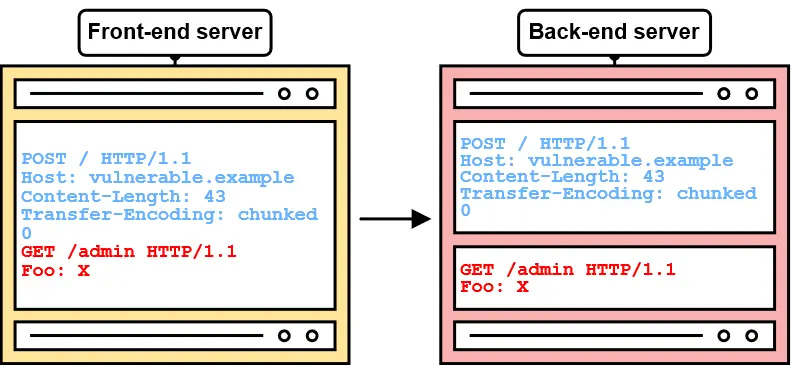
SMTP smuggling?
The initial goal of this research was to test the SMTP protocol against some common and exotic attacks that work on other protocols, such as HTTP. Thanks to the contribution of many brilliant minds, there is a variety of HTTP attacks to choose from. However, in the context of SMTP, one of them just fits the bill. HTTP request smuggling!
If you want an in-depth explanation of HTTP request smuggling and all its facets, James Kettle (aka @albinowax) did a wonderful job on that. However, for now, we only need to understand the essentials!
With HTTP request smuggling, we’re basically trying to exploit different interpretations of the same thing. For example, with discrepancies in the interpretation and processing of the ‘Content-Length’ and ‘Transfer-Encoding’ HTTP headers, an arbitrary HTTP request can be smuggled to an otherwise unreachable back-end server (Figure 6).
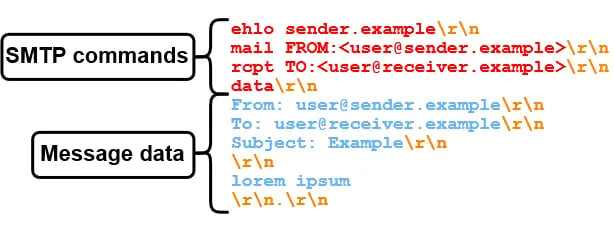
In this example, the vulnerable front-end server only sees one HTTP POST request, while the back-end server sees a POST request and a GET request to /admin!
With SMTP, we also have a setup with two servers, outbound and inbound SMTP servers. So, let’s take a look at an SMTP session again in Figure 7.
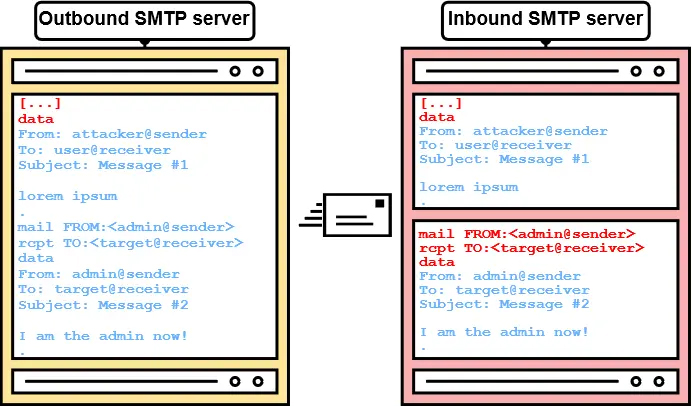
Now tell me, what happens if outbound and inbound SMTP servers interpret the end-of-data sequence (<CR><LF>.<CR><LF>)differently?
Exactly, SMTP smuggling!
If SMTP servers have a different understanding of where the message data ends, an attacker can potentially break out of the message data. Even worse, this may allow us to specify arbitrary SMTP commands and even to send separate emails (Figure 8)!

So, that’s the basic idea of SMTP smuggling! But does it actually work?
<CR><LF>.<CR><LF> is a lie?
To get a good understanding of how different kinds of SMTP software work, we can start our analysis as shown in Figure 9:
First, we register email accounts at various public email providers that support mail submissions via SMTP (unlike Tutanota and ProtonMail). We used the following providers for this research project:
- outlook.com
- gmail.com
- gmx.net
- icloud.com
- zoho.com
- fastmail.com
- runbox.com
- startmail.com
- mailbox.org
- aol.com
- yahoo.com
- web.de
Then, by sending emails through the outbound SMTP servers of these providers and receiving them on an inbound SMTP analysis server, we can see the first differences in the implementation of the SMTP protocol in these SMTP servers.
When looking at the SMTP analysis client it becomes apparent straight away that some SMTP products do things ‘differently’ than others. For example, here are some responses received from email providers after sending the DATA SMTP command:
- 250 End data with <CR><LF>.<CR><LF>
- 250 Start mail input; end with <CRLF>.<CRLF>
- 250 Send data ending with <CRLF>.<CRLF> This doesn’t look good for our plans to smuggle SMTP commands since we’re looking for different interpretations of SMTP, and not the same text written differently. Right? But, we’re not going to back off just because of some text, are we?
After further analysis, some SMTP servers returned the following responses, which looked a bit more promising:
- Enter message, ending with "." on a line by itself
- Enter mail, end with "." on a line by itself Why would that be more promising, though? Well, different operating systems have a different understanding of ‘a line by itself’. A ‘.‘ on a line by itself on Windows would be separated via two carriage return line feeds (<CR><LF>.<CR><LF> or \r\n.\r\n), while a ‘.‘ on a line by itself on Linux would be separated with two line feeds (<LF>.<LF> or \n.\n).
So, why don’t we try to end the message data of an email with <LF>.<LF>? This would therefore look like Figure 10.

Now, if an SMTP server doesn’t consider <LF>.<LF> as the end-of-data sequence, the connection will be left hanging, since it’s waiting for the actual <CR><LF>.<CR><LF>. Therefore, as shown in Figure 11, we add the following.

With this, whenever <LF>.<LF> is supported as an end-of-data sequence by the inbound SMTP server, only ‘lorem ipsum’ will be part of the message data, otherwise, the message also includes “This server is ignoring line feeds as end-of-data sequence!”.
But, what can we actually achieve with this? Well, let’s see what a message transfer could look like if <LF>.<LF> doesn’t end the data section (Figure 12).
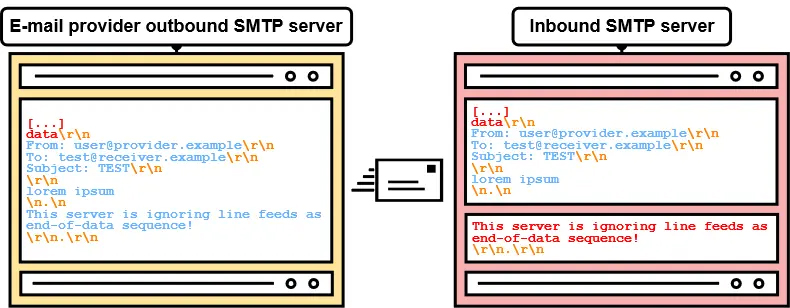
Depending on the receiving inbound SMTP server this may be completely harmless. However, what if the inbound SMTP server interprets <LF>.<LF> as the end-of-data sequence? (Figure 13).
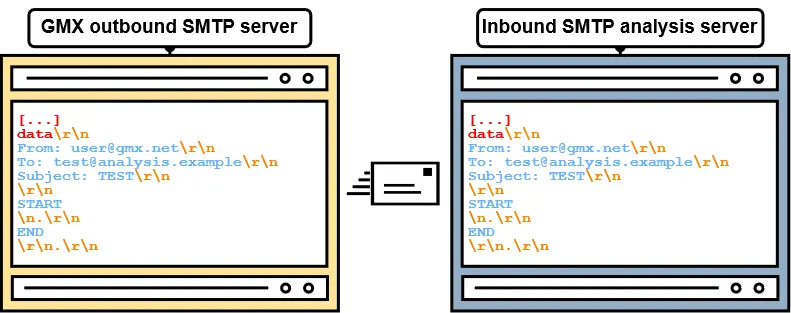
In this case, the ‘harmless’ <LF>.<LF> breaks out of the message data and “This server is ignoring line feeds as end-of-data sequence!” may now be interpreted as an SMTP command! Note that this requires the inbound server to accept multiple SMTP commands in a batch, or so-called SMTP pipelining. Luckily for us, most servers support this nowadays.
However, outbound SMTP servers commonly handle such ‘troublesome’ <LF>.<LF> sequences via different means:
- Dot-stuffing (Escaping the single dot with another dot): <LF>..<LF>
- Replacing it with a <CR><LF>
- Encoding it (for example, via quoted-printable): =0A.=0A
- Removing the entire sequence
- Not sending the message
But sometimes, they do nothing at all!
So, essentially, we’re looking for specific characteristics in outbound and inbound SMTP servers in terms of end-of-data sequence handling. More precisely, we’re searching for what outbound SMTP servers ignore (for example, <LF>.<LF>) and what inbound SMTP servers interpret (for example, <LF>.<LF> as end-of-data). If we can find a correct combination, we can smuggle!
First blood
As previously mentioned, we’ve created email accounts at various email providers. Shortly after sending potential end-of-data sequences (for example, <LF>.<LF>) from outbound provider SMTP servers to the SMTP analysis server, a promising candidate emerged!
GMX, established in 1997, is one of the old-school email providers in the DACH region with roughly 20 million users. When sending an <LF>.<CR><LF> sequence to the outbound GMX SMTP server, it is passed unfiltered to the inbound SMTP server, as shown in Figure 14!
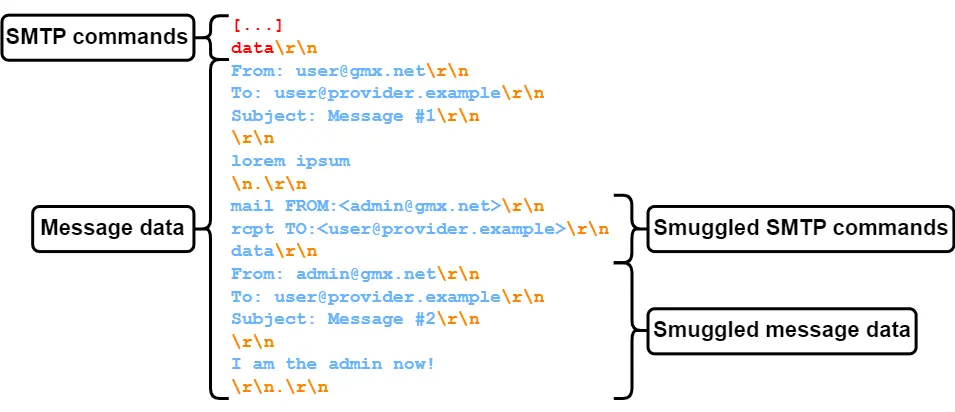
Therefore, we can now break out of the message data at the inbound SMTP server, if <LF>.<CR><LF> is interpreted as an end-of-data sequence. So, how do we find such servers?
We simply send an email with the following message data (Figure 15) to all the email addresses we’ve registered.
For a lot of them, we receive a very suspicious-looking email (Figure 16), since <LF>.<CR><LF> did not end the message data.
But for some of them, we hit the jackpot!
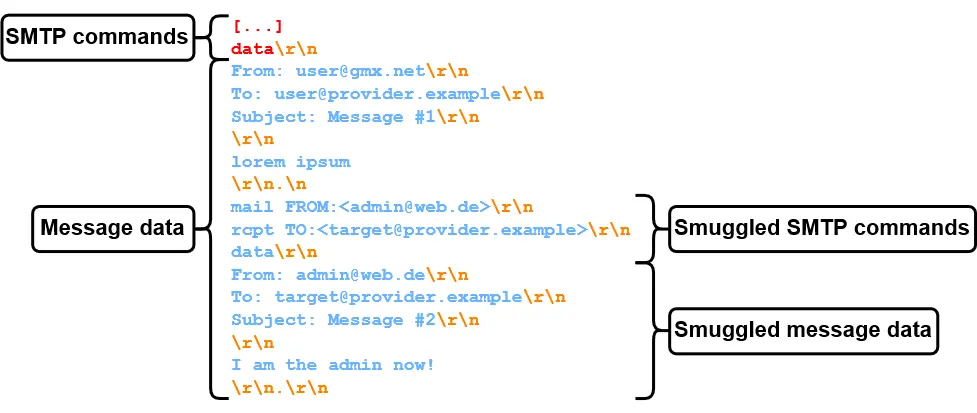
This proof of concept (Figure 17) was the first sign that SMTP smuggling actually works!
By inspecting the message headers, we can see that the SPF check passes with domain alignment for gmx.net! This is because the smuggled message actually came from the legitimate GMX SMTP server.
Received-SPF: pass
(gmx.net: 212.227.15.15 is authorized to use 'admin@gmx.net' in 'mfrom' identity (mechanism 'ip4:212.227.15.0/25' matched))
receiver=mx4.messagingengine.com;
identity=mailfrom;
envelope-from="admin@gmx.net";
helo=mout.gmx.net;
client-ip=212.227.15.15Since we’ve achieved domain alignment for gmx.net, this email will most likely pass spam filters, even with strict DMARC policies! But wait, if other domains also use the outbound SMTP server of GMX to send emails, can’t we spoof them as well? Let’s see! By analysing the SPF record of web.de, we can see that the outbound SMTP IP address of GMX 212.227.15.15 is included as well!
v=spf1 ip4:212.227.126.128/25 ip4:212.227.15.0/25 ip4:212.227.17.0/27 ip4:217.72.192.248/29 ip4:82.165.159.0/26 ip4:217.72.207.0/27 ip4:217.72.192.64/26 ip4:82.165.229.130 ip4:82.165.230.22 ~all Now, we can change the SMTP smuggling message data accordingly (Figure 18).

To simulate a real-life scenario, we specify a different receiver email address for the first message and only send the smuggled message (Figure 19) to the target.
In this case, our target would even see the associated profile picture (in this case of the real admin@web.de user), like in Figure 20!
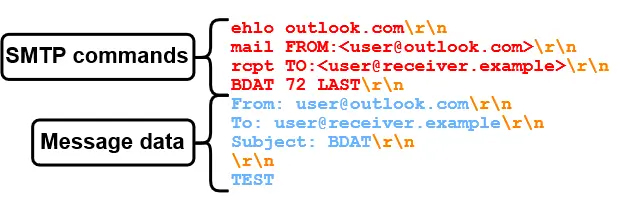
And again, the SPF verification checks out!
Received-SPF: pass
(web.de: 212.227.17.22 is authorized to use 'admin@web.de' in 'mfrom' identity (mechanism 'ip4:212.227.17.0/27' matched))
receiver=mx4.messagingengine.com;
identity=mailfrom;
envelope-from="admin@web.de";
helo=mout.gmx.net;
client-ip=212.227.17.22 Now, you might think that this was already cool, but we’re just getting started!
Even though we initially only analysed GMX, the problem is far worse than it seemed at first. Like many big email providers, GMX is using a custom SMTP server called NemesisSMTPd. Since GMX is part of Ionos, emailing services provided by Ionos are also using Nemesis SMTPd.
By putting 1 and 1 together, we register an email domain at Ionos and check if SMTP smuggling works. And it does! However, smuggling via a custom email domain doesn’t even seem to be necessary. The SPF record for the registered email domain includes _spf-eu.ionos.com and the SPF record for gmx.net includes _spf.gmx.net. Examining the permitted IP ranges reveals ‘some’ collisions:
$ dig _spf-eu.ionos.com TXT
"v=spf1 ip4:212.227.126.128/25 ip4:212.227.15.0/25 ip4:212.227.17.0/27 ip4:82.165.159.0/26 ip4:217.72.192.64/26 ?all$ dig _spf.gmx.net TXT
"v=spf1 ip4:212.227.126.128/25 ip4:212.227.15.0/25 ip4:212.227.17.0/27 ip4:82.165.159.0/24 ip4:74.208.4.192/26 ip4:217.72.207.0/27 ip4:82.165.229.31 ip4:82.165.230.21 ip4:213.165.64.0/23 ip4:74.208.5.64/26 ~all" So, either way, this allowed spoofing of not only gmx.net and web.de, but also around a million other domains hosted at Ionos! But more on the details later!
Smuggling via Microsoft Exchange Online
After a deeper analysis of outbound SMTP servers, a peculiarity in Microsoft Outlook’s (outlook.com) SMTP server was observed. When trying to send an <LF>.<LF> sequence, the message does not get transmitted, and the following error message is returned:
The remote server returned 550 5.6.11 SMTPSEND.BareLinefeedsAreIllegal; message contains bare linefeeds, which cannot be sent via DATA and receiving system does not support BDAT.
However, the same as GMX, Outlook doesn't filter <LF>.<CR><LF> sequences.
Still, it wasn’t possible to smuggle to the same receivers (such as Fastmail) as with GMX. The reason for this is Outlook’s usage of the optional BDAT SMTP command. BDAT is an alternative to the DATA command to transfer the message data. It works by specifying the message length with the BDAT command, instead of relying on an end-of-data sequence. For example, to transfer 72 bytes of message data (Figure 21).
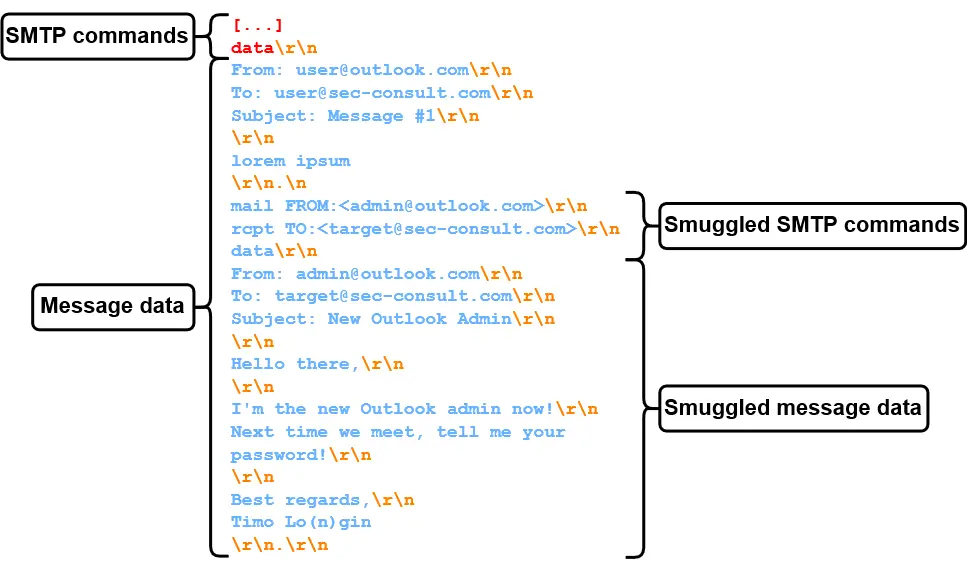
Even though that stops us from smuggling to some inbound SMTP servers, the BDAT command can only be used by Outlook, if the inbound SMTP server supports it. If the inbound SMTP server doesn’t indicate BDAT support by returning the CHUNKING capability, DATA is used as a fallback.
Therefore, we’re looking for an inbound SMTP server that interprets <LF>.<CR><LF> as an end-of-data sequence and doesn’t support BDAT.
Funnily enough, the sec-consult.com SMTP server supports just that! Note that LOTS of servers on the Internet support this, but since we’ve got to make sure that our own systems are secure anyway, we’ll be using sec-consult.com. So, what’s the first thing to do with our newly gained power? Sending spoofed emails to co-workers to make sure it actually works (Figure 22).

Based on their reaction (Figure 23), the message from admin(at)outlook.com definitely got delivered and didn’t end up in spam.
The actual email is shown in Figure 24.
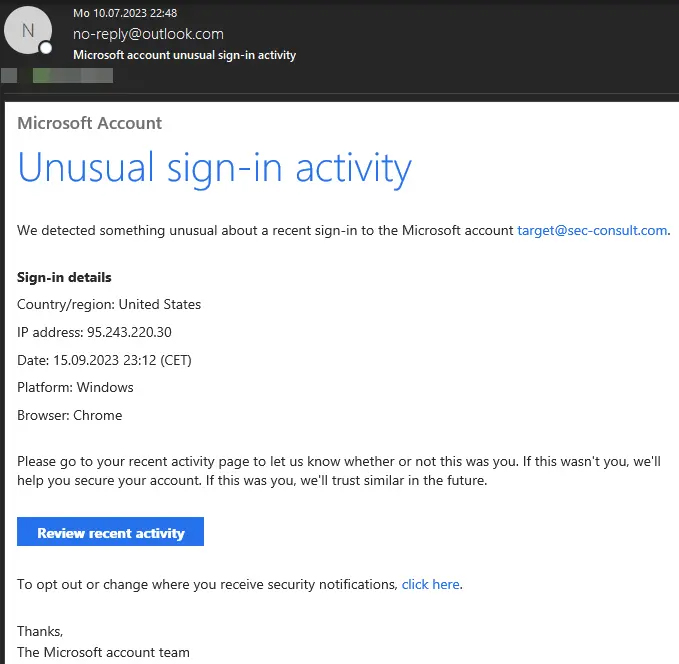
We can once more confirm SPF alignment by looking at the message headers.
Received-SPF: Pass (mx3.atos.net: domain of admin(at)outlook.com designates 40.92.75.68 as permitted sender)
identity=mailfrom; client-ip=40.92.75.68;
receiver=mx3.atos.net; envelope-from="admin@outlook.com";
x-sender="admin@outlook.com"; x-conformance=spf_only;
x-record-type="v=spf1"; x-record-text="v=spf1
ip4:40.92.0.0/15 ip4:40.107.0.0/16 ip4:52.100.0.0/14
ip4:104.47.0.0/17 ip6:2a01:111:f400::/48
ip6:2a01:111:f403::/49 ip6:2a01:111:f403:8000::/50
ip6:2a01:111:f403:c000::/51 ip6:2a01:111:f403:f000::/52 -all" Since the previous examples were only text-based, attackers could also use HTML, for some more convincing phishing emails (Figure 25).
However, to keep it simple, we’ll stick to just text.
So, this is cool, but again, that’s not everything! Since the outbound Outlook SMTP server is not only used for emails by outlook.com, but for the entirety of Exchange Online, we can now send emails from every domain that uses Exchange Online to send emails!
Since this affects LOTS of companies (as later discussed in the SMTP Smuggling Impact section), we can choose our sender domain freely. We can even use sec-consult.com itself! (Figure 26).
As before, the SPF check succeeds with domain alignment, since sec-consult.com uses Exchange Online and the SPF record includes the respective Exchange Online SPF domain spf.protection.outlook.com.
Received-SPF: Pass (mx4.atos.net: domain of ceo(at)sec-consult.com
designates 40.92.48.103 as permitted sender)
identity=mailfrom; client-ip=40.92.48.103;
receiver=mx4.atos.net; envelope-from="ceo@sec-consult.com";
x-sender="ceo@sec-consult.com"; x-conformance=spf_only;
x-record-type="v=spf1"; x-record-text="v=spf1
ip4:40.92.0.0/15 ip4:40.107.0.0/16 ip4:52.100.0.0/14
ip4:104.47.0.0/17 ip6:2a01:111:f400::/48
ip6:2a01:111:f403::/49 ip6:2a01:111:f403:8000::/50
ip6:2a01:111:f403:c000::/51 ip6:2a01:111:f403:f000::/52 -all" With GMX and Exchange Online out of the way, we’re now approaching our last target!
Smuggling to Amazon, PayPal, eBay, …, on the road to Cisco
GMX and Exchange Online allow SMTP smuggling due to insufficient sanitization at their outbound SMTP servers, but what about insecure inbound SMTP servers? What if there are inbound SMTP servers that allow such non-restrictive end-of-data sequences that even the most restrictive outbound SMTP servers would let such sequences through?
To get to the bottom of this, we can use a scanner that sends emails to inbound SMTP servers but uses exotic end-of-data sequences. If the connection to the inbound SMTP server times out, the exotic end-of-data sequence is ignored. Otherwise, we most likely found something interesting!
So, what exactly is ‘exotic? Exotic end-of-data sequences could for example be:
- Interrupted end-of-data sequences:
- <CR><LF>\x00.<CR><LF>
- <CR><LF>.\x00<CR><LF>
- End-of-data sequences using incomplete CRLFs:
- <LF>.<LF>
- <CR><LF>.<CR>
- <CR>.<LF>
- End-of-data sequences in the message header
The message data of such an ‘exotic’ email could look like Figure 27.

Now, by scanning the former Alexa Top 1000, various inbound SMTP servers accepting such sequences were identified! However, only one of those sequences seems to be working for lots of SMTP servers: <CR>.<CR>.
This sequence gets accepted by the inbound email servers of some really high-value targets:
- Amazon
- PayPal
- eBay
- Cisco
- The IRS
The one thing that they all have in common is that they’re using Cisco Secure Email, with on-prem Cisco Secure Email Gateway or cloud-based Cisco’s Secure Email Cloud Gateway. And again, for some odd reason, sec-consult.com is using Cisco Secure Email Gateway as well!
As a proof of concept (Figure 28), we can now send an email from admin(at)icloud.com to our target at sec-consult.com, as, like with many other outbound SMTP servers (further discussed in SMTP Smuggling Impact), <CR>.<CR> doesn’t get filtered (Figure 29)
Like before, the email goes through unscathed, as shown in Figure 29.
SPF checks pass with domain alignment, and without any issues.
Received-SPF: Pass (mx4.atos.net: domain of admin(at)icloud.com
designates 17.57.155.23 as permitted sender)
identity=mailfrom; client-ip=17.57.155.23;
receiver=mx4.atos.net; envelope-from="admin@icloud.com";
x-sender="admin@icloud.com"; x-conformance=spf_only;
x-record-type="v=spf1"; x-record-text="v=spf1
ip4:17.58.0.0/16 ip4:17.57.155.0/24 ip4:17.57.156.0/24
ip4:144.178.36.0/24 ip4:144.178.38.0/24 ip4:112.19.199.64/29
ip4:112.19.242.64/29 ip4:222.73.195.64/29 ip4:157.255.1.64/29
ip4:106.39.212.64/29 ip4:123.126.78.64/29
ip4:183.240.219.64/29 ip4:39.156.163.64/29 ~all" Hence, DMARC passes as well:
Authentication-Results-Original: mx4.atos.net; dkim=none (message not signed)
header.i=none; spf=Pass smtp.mailfrom=admin@icloud.com; spf=None
smtp.helo=postmaster@qs51p00im-qukt01080502.me.com; dmarc=pass (p=quarantine
dis=none) d=icloud.com With Cisco’s Secure Email covered, we can now go on and take a look at the global impact!
SMTP smuggling impact
At this point, we’ve covered lots of outbound and inbound SMTP smuggling. But, speaking globally, how bad is it?
GMX and Ionos
SMTP smuggling via GMX and Ionos email services allowed SMTP smuggling from roughly 1.35 million different domains, as indicated by the domains pointing their MX record to Ionos (Figure 30).

Checking the SPF record of these domains confirms that they are most likely all permitting _spf-eu.ionos.com for sending emails.
However, as already mentioned, SMTP smuggling doesn’t work for every receiving inbound SMTP server and, in this case, requires inbound SMTP servers to accept <LF>.<CR><LF> as an end-of-data sequence. So, who’s affected?
Only a few of the bigger email providers that were tested are affected. These include Fastmail and Runbox.
This might not seem bad at first, but looking at affected SMTP software on the Internet is a different story. After testing some popular email software in their default configuration, it turned out that Postfix and Sendmail fulfil the requirements, are affected, and can be smuggled to. Speaking globally, this is a lot (Figure 31)!
Aside from Postfix and Sendmail, other SMTP implementations are most likely affected as well, including Cisco Secure Email (Cloud) Gateway, which we’ll get to shortly.
Microsoft Exchange Online
The same as GMX and Ionos, Exchange Online allowed smuggling via a <LF>.<CR><LF> end-of-data sequence as well, which makes it possible to smuggle from every domain pointing their SPF record to Exchange Online. This amounts to millions of domains all across the globe, including some very high-value targets owned by Microsoft like microsoft.com, msn.com, github.com, outlook.com, office365.com, openai.com and many more, and also domains of their customers (such as tesla.com, mastercard.com, nike.com, and so on).
However, as previously mentioned, smuggling from Exchange Online is even more restricted than from GMX/Ionos, since the receiving inbound SMTP server must support BDAT. This is the case for Fastmail and — still — hundreds of thousands of Postfix and Sendmail servers.
| Software | Without BDAT/CHUNKING | Total | Percentage | Shodan query |
| Postfix | 716,884 | 1,475,616 | ~50% | postfix port:25 -CHUNKING |
| Sendmail | 168,823 | 169,030 | ~99% | sendmail port:25 -CHUNKING |

These numbers from Shodan might not paint the whole picture though, as many servers may be running Postfix, but are hiding their identification banner. Also, other smaller SMTP servers are affected as well, again including Cisco Secure Email (Cloud) Gateway.
We did not analyse all SMTP software out there, hence it might be possible that other vulnerable servers exist as well.
Cisco Secure Email (Cloud) Gateway
The Cisco Secure Email Gateway and its cloud counterpart, the Cisco Secure Email Cloud Gateway, are both ‘vulnerable’ to inbound SMTP smuggling. The quotes are necessary in this case, since, according to lengthy discussions with Cisco, this is not a bug, but a feature (see the responsible disclosure section)!
By default, Cisco Secure Email (Cloud) Gateway accepts <CR>.<CR> as the end-of-data sequence, which does not get filtered by the following SMTP servers when sending outbound:
- Outlook/Exchange Online
- Icloud
- On-premise exchange server
- Postfix
- Sendmail
- Startmail
- Fastmail
- Zohomail
This would allow inbound SMTP smuggling to around 40k domains using Cisco’s Secure Email Cloud Gateway, if they’re using the default configuration (like we did). These domains can be determined by checking a passive DNS database like SecurityTrails for iphmx.com subdomains. Identifying on-premise Cisco Secure Email Gateways on the other hand is a difficult task, since several Internet-wide scanners (for example, Shodan) seem to get blocked when conducting service scans. However, to get a better feeling for the usage of this product, we scanned the former Alexa Top 1,000 and discovered at least the following 32 domains.
- amazon.com
- amazon.co.jp
- amazon.co.uk
- amazon.it
- amazon.fr
- marriott.com
- cisco.com
- amazon.in
- paypal.com
- amazon.ca
- goodreads.com
- webex.com
- custhelp.com
- imdb.com
- intuit.com
- ndtv.com
- amazon.cn
- makemytrip.com
- amazon.com.au
- amazonaws.com
- primevideo.com
- amazon.es
- irs.gov
- amazon.com.br
- aastocks.com
- ebay.com
- amazon.de
- ebay.de
- ebay.co.uk
- ebay.com.au
- mayoclinic.org
- audible.com
Note that this doesn’t take into account servers that don’t have an MX record let alone an SMTP server.
Further vulnerabilities
During the research, we’ve also discovered some exotic inbound SMTP servers that interpret end-of-data sequences like <CR><LF>\x00.<CR><LF>, with \x00 representing a null byte. With proprietary SMTP components and lots of different email services intertwined it’s hard to tell what is possible until an email reaches its final destination.
Even though SMTP smuggling might still be hiding in some places, we hopefully eliminated some big targets.
Responsible disclosure
How do we report a vulnerability that is based on protocol interpretation? Who is right, and who is wrong? Let’s take a look at some RFCs!
In general, RFC 5321 from 2008 states the following:
The custom of accepting lines ending only in <LF>, as a concession to non-conforming behavior on the part of some UNIX systems, has proven to cause more interoperability problems than it solves, and SMTP server systems MUST NOT do this, even in the name of improved robustness. In particular, the sequence “<LF>.<LF>” (bare line feeds, without carriage returns) MUST NOT be treated as equivalent to <CRLF>.<CRLF> as the end of mail data indication.
RFC 5321
So, it’s the inbound SMTP server’s fault! But wait, RFC 5322, also from 2008, says the following about the body of a message:
CR and LF MUST only occur together as CRLF; they MUST NOT appear independently in the body.
RFC 5322
This essentially means that both sides (outbound and inbound) are at fault! Also, this shows us that inconsistent interpretation of the end-of-data sequence is not a novel issue. Now, what do the affected parties think about this? We have thus initiated our responsible disclosure process around the end of July 2023 (see Timeline further below).
GMX
The responsible disclosure process with GMX was pure bliss. After immediately receiving a response, the issue was fixed in roughly ten days. Aside from paying a bounty, they even added Timo to their Bug Bounty Hall of Fame. All-in-all, a great experience! Huge props to GMX for such a professional and quick reaction.
Microsoft
The outbound SMTP smuggling vulnerability was submitted via the Microsoft Security Response Center (MSRC). Roughly a month later, Microsoft replied:
Thank you again for submitting this issue to Microsoft. Currently, MSRC prioritizes vulnerabilities that are assessed as “Important” or “Critical’’ severities for immediate servicing. After careful investigation, this case has been assessed as moderate severity and does not meet MSRC’s bar for immediate servicing since the attack only works if the mail server of the recipient treats a non-standard EOD sequence as EOD . However, we have shared the report with the team responsible for maintaining the product or service. They will take appropriate action as needed to help keep customers protected.
Via direct communication
Fair enough, they got bigger fish to fry! After retesting the issue every now and then, they seem to have fixed it roughly in the middle of October 2023.
Cisco
As previously mentioned, the ‘vulnerability’ in Cisco Secure Email (Cloud) Gateway is not a bug, but a feature. And, unlike in most cases, this is actually somewhat true.
Cisco Secure Email (Cloud) Gateway can be configured to handle carriage returns and line feeds in a special manner, as seen here.
However, by default, Cisco Secure Email (Cloud) Gateway ‘Allows’ the message, but converts bare CR and LF characters to CRLF characters’ (the vulnerable ‘Clean’ setting), which basically enables inbound SMTP smuggling via <CR>.<CR> end-of-data sequences. We have communicated this issue to Cisco and CERT/CC and went back and forth quite a bit. But at the end of the day, it’s not a bug, it’s a feature.
Since this feature allowed us to send spoofed emails from arbitrary Exchange Online domains straight into our inboxes, we decided to change the configuration to “Allow”.
This passes emails with bare carriage returns or line feeds onto our actual email server (Cisco Secure Email Gateway is just a gateway), which only interprets <CR><LF>.<CR><LF> as end-of-data sequence. If you don’t want to receive spoofed emails with valid DMARC checks, we highly recommend changing your configuration!
Conclusion
We’ve shown a novel SMTP spoofing technique with this research that allows email spoofing from millions of domains.
Even though Microsoft and GMX have patched this issue promptly, inbound SMTP smuggling to Cisco Secure Email instances (cloud and on-premise) is still possible with default configurations. We highly encourage changing these default configurations, as described in the responsible disclosure section.
Also, hopefully this blog post has sparked further interest in SMTP research, as there is still so much to explore. Even with SMTP smuggling alone, there are many things to examine:
- Other smuggling techniques
- Bounce smuggling
- Smuggling via BDAT
- Smuggling dangerous/exotic SMTP commands
- Internet-wide scans
- Other SMTP software
- and more
So, this is probably not the last time you’ve heard of SMTP smuggling!
Timeline
| 7/6/2023 | First outbound SMTP smuggling proof of concept (GMX) |
|---|---|
| 8/6/2023 | Discovery of outbound SMTP smuggling in Exchange Online |
| 20/6/2023 | Discovery of Cisco Secure Email (Cloud) Gateway inbound SMTP smuggling |
| June and July 2023 | Developing tools, analysing test cases, further research |
| 26/7/2023 | Contacting MSRC |
| 27/7/2023 | Contacting Cisco |
| 29/7/2023 | Contacting GMX |
| 10/8/2023 | GMX fixed the issue |
| 17/8/2023 | Contacting CERT Coordination Center (CERT/CC) for further discussion with Cisco |
| 23/8/2023 | Microsoft responds and rates the vulnerability with moderate risk |
| 13/9/2023 | CERT/CC accepts the case |
| 16/102023 | SMTP smuggling in Exchange Online is fixed |
| 29/11/2023 | CERT/CC allows public release of SMTP smuggling, since no software vulnerabilities were identified (“it’s not a bug, it’s a feature”) |
| 5/12/2023 | Informing CERT.at and CERT-Bund about planned release, providing blog post draft, warning about Cisco configuration |
| 28/12/2023 | Release date of blog post |
FAQs
How do I know if I am affected?
If you are a user of a big email provider (Outlook, Gmail, and so forth), you are most likely going to be fine (for now at least). Since SMTP smuggling is a fairly new topic and still has things to explore, we cannot be certain though. However, if you’re using Cisco Secure Email (cloud or on-premise), you should definitely check your configuration (see the responsible disclosure section). But, as always, don’t blindly trust anything that lands in your email inbox!
Update from 10/01/2024: Official tools to test for SMTP smuggling issues are now available on GitHub!
Is there a tool available to verify whether I am vulnerable?
Update from 10/01/2024: Official tools to test for SMTP smuggling issues are now available on GitHub!
We developed an analysis tool internally but decided to publish it at a later date. As Cisco Secure Mail installations were affected by the issue, we notified CERT.at and CERT-Bund before publishing the post and presenting at the 37C3 conference.
Do smuggled emails always get past spam filters?
The short answer is no, not always! Even though the smuggled email might come from a legitimate sender and pass email authentication due to SPF alignment, the email might still get blocked, depending on the email contents and other factors. Also, if more than SPF alignment is required for the email to go through, we’re out of luck with SMTP smuggling.
How would someone even get the idea of looking at a protocol like SMTP?
There are two major reasons:
- SMTP is a very old protocol that is somewhat flying under the radar of a lot of security researchers (kind of like DNS). Since there wasn’t any related research that indicated similar attacks, the chances were good for finding something new!
- Phishing is one of the best ways for threat actors or our red teamers to gain initial access to an organization. Therefore, looking for vulnerabilities in the underlying email protocol — SMTP — seemed natural.
Is this a novel attack technique?
Most likely! Again, for two major reasons:
- Microsoft’s SMTP infrastructure including Exchange Online was vulnerable. This would have most likely been found and fixed by prior researchers.
- We haven’t found any research stating otherwise.
Are there other interesting SMTP and emailing attacks?
Yes, lots of them! For example, “Weak Links in Authentication Chains: A Large-scale – Analysis of Email Sender Spoofing Attacks” shows a range of interesting attacks that even worked with Gmail!
Can confusions of <CR><LF> and <LF> and alike cause security issues in other protocols as well?
Yes, of course! In general, implementations of (sometimes) vague specifications can cause all kinds of security issues.
Have you scanned the whole Internet and tested ALL emailing services?
As already mentioned, scanning email services for used software and versions may yield inaccurate results and will most likely get you on some kind of blacklist. The same goes for more specific end-of-data sequence checks, where basically a whole email is sent. Therefore, we could roughly only analyse the top 10k of Alexa domains during this research.
Timo Longin (also known as Login) is a senior security consultant at SEC Consult at day and a security researcher at night interested in finding forgotten and new exploitation techniques that make the unthinkable possible!
The views expressed by the authors of this blog are their own and do not necessarily reflect the views of APNIC. Please note a Code of Conduct applies to this blog.



